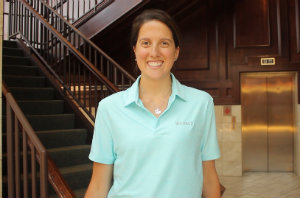On the Road to Wellness: How One Dietitian is Driving Truckers Toward Health


James M. Loy, Miami University
Listen to the audio podcast
Read the story
Anyone who’s driven long distances likely knows how demanding it can be.
Disrupted sleep schedules, a lack of nutritious roadside eating options, increased isolation and prolonged periods behind the wheel can quickly introduce a battery of stressors that make it difficult to stay healthy on the road.
Now imagine doing this day in and day out, all day every day, for years on end, and it’s not hard to see why truck driving can be among the unhealthier professions. And drivers are certainly not alone. Similar issues stretch across the entire industry.
“Transportation is a very unique niche,” says Ali John, Registered Dietitian, Nutritionist and Manager of Corporate Wellness for Werner Enterprises. “They don’t have the same schedule every day. They work in environments that are unique in terms of space and most of the time they don’t get paid unless they are sitting down.”
A different road to wellness
For those outside the industry, transportation might not be the most obvious career path for a dietitian or a nutritionist. “I definitely think that the transportation sector isn’t the first industry most dietitians would consider as a career path,” John says. “Working in a hospital is definitely the norm for dietitians.”
But there is certainly a great need for the work she does. On average, truck drivers have high blood pressure, high cholesterol and increased obesity rates. Most also get less than six hours of sleep daily, have less opportunities to stay physically active and they tend to smoke more.  Ali John
Ali John
These are just some of the health concerns that John helps alleviate. And it’s a professional role she began pursuing as a dietetic major at Miami University, where she landed a field experience with Verizon, which then led her into the transportation industry, first with CSX, a major railroad company, and now with Werner, one of the world’s largest truckload carriers.
Today, she single-handedly orchestrates a wellness program for more than 12,000 employees. However, until recently, Werner’s wellness program was mostly limited to its corporate headquarters, serving about 1,400 people.
Since John joined the company, the program has expanded to include the nearly 10,000 professional drivers who make up most of the company’s work force, and those who also face the serious wellness risks that can not only destroy their health, but also their entire livelihoods.
“Our professional drivers have to be pretty healthy to continue to drive,” John says. “They have to pass a CDL physical and a lot of those physical markers are related to wellness. If it turns out they have uncontrolled diabetes, they can’t drive anymore. Not only is that our lifeline for Werner as a company, but it is also a driver’s lifeline. If you can’t drive, you’re not getting paid.”
Communication is key
John’s mission is to engage as many employees as possible, and her program spans across a comprehensive campaign designed to help every Werner associate, especially professional drivers, “eat well, train well, drink well, be well and sleep well.”
All Werner drivers receive direct health-related information through an in-cab communication device. She’s implemented “Wellness Wednesdays” that offer quick and simple health tips and a variety of additional quick reference guides that keep other important information continually top-of-mind, especially as it relates to a life on the road.
“Wellness is something where you have to meet somebody where they are,” John says. “Everybody generally wants to be slightly healthier. They just don’t know how to do it. So, communication is really key, and communicating in a way that says, ‘I understand what you are going through, but here’s how you can get here too.’”
For John, there may be many unique considerations specific to the world of transportation. Overall, it’s a strategy now being embraced across most industries, which is also creating more and more opportunities for new health and wellness professionals.
“Healthcare costs have gone up and up and Americans, unfortunately, are less and less well with every passing year,” John says. “All those statistics are a precursor to a lot of diseases that wellness programs can help alleviate. So, it is a growing industry for companies. The ideal goal of any wellness program is to drive down the cost of health insurance. Healthier employees cost less for both the company and themselves.”
And that can be a win-win for everyone, even for John, who gets to see the real difference she makes.
“I am really proud when people ask me what I do,” she says. “My proudest moments are when my associates achieve their goals. When I am working closely with someone who has high blood pressure or they are overweight, and they start to see the progress they can have as they eat healthier and incorporate a little exercise into their daily lives, their success is my success.”

